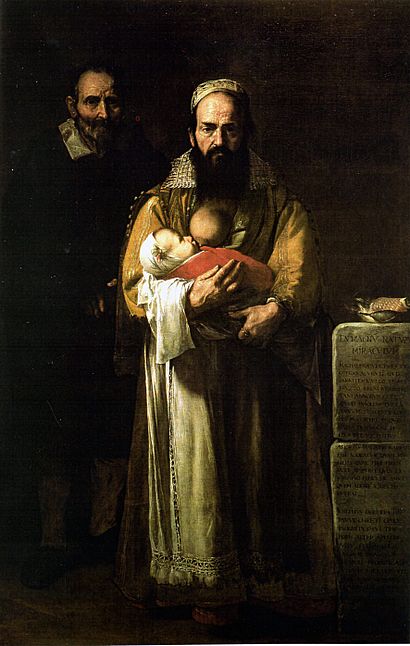Magdalena Ventura with Her Husband and Son facts for kids
Quick facts for kids Magdalena Ventura with Her Husband and Son |
|
|---|---|
| The Bearded Woman | |
 |
|
| Year | 1631 |
| Dimensions | 212 cm (83 in) × 144 cm (57 in) |
| Location | Louvre, Real Academia de Bellas Artes de San Fernando, Hospital de Tavera |
| Owner | Fernando Afán de Ribera |
Magdalena Ventura with Her Husband and Son is a famous painting from 1631. It is also known as The Bearded Lady. The Spanish artist Jusepe de Ribera created this oil painting. Today, you can see it at the Museo Nacional del Prado in Madrid, Spain.
Contents
What the Painting Shows
This painting shows a woman named Magdalena Ventura. She is standing and feeding her baby. Her husband stands behind her, mostly in the shadows.
- On the right side of the painting, there are two stone tablets.
- The top tablet tells her family's story in Latin. It calls her "A Wonder of Nature."
- The second tablet praises her unique qualities. It also mentions the artist and the proud owner who asked for the painting.
Magdalena's Story
All we know about Magdalena Ventura comes from this painting and old writings about it. People say that a rich man, the Duke of Alcalá, heard stories about her. He was so interested that he asked Ribera to paint her.
- The stone tablet in the painting says Magdalena was 52 years old when it was painted.
- It also says she started growing facial hair when she was 37.
- She had at least two other children and was from a region in Italy called Abruzzi.
Why Magdalena Was Painted This Way
Magdalena's long, untrimmed beard is very noticeable in the painting. It is very different from her husband's neatly trimmed beard. Her unique appearance might have been a way for her family to earn money.
- The way she stands while nursing her baby is also unusual for women in the 1600s.
- This pose was sometimes linked to stories of strong women from Africa.
- By painting Magdalena Ventura in this way, the artist showed her strength and unique qualities.
A Gallery of Unique People
This painting was part of a collection of portraits. These portraits showed people who were considered "unusual" at the time. Many of these people had features that were popular in traveling shows.
- For example, Ribera later painted another portrait in 1642.
- This painting was called The Clubfoot, and it showed a boy with a club foot.
See also
 In Spanish: La mujer barbuda (Magdalena Ventura con su marido) para niños
In Spanish: La mujer barbuda (Magdalena Ventura con su marido) para niños
- Bearded lady

